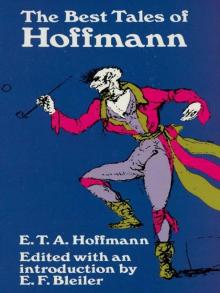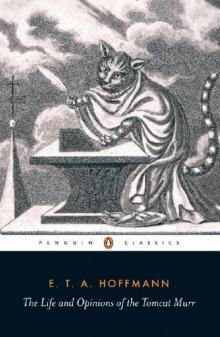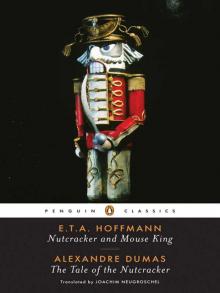- Home
- E. T. A. Hoffmann
The Best Tales of Hoffmann
The Best Tales of Hoffmann Read online
DOVER BOOKS ON LITERATURE AND DRAMA
PRIDE AND PREJUDICE, Jane Austen. Illustrated by Hugh Thomson. (0-486-44091-5)
VILLETTE, Charlotte Brontë. (0-486-45557-2)
ONE OF OURS, Willa Cather. (0-486-45599-8)
TEN PLAYS, Anton Chekhov. (0-486-46560-8)
THE HOUSE BEHIND THE CEDARS, Charles W. Chesnutt. (0-486-46144-0)
TREMENDOUS TRIFLES, G. K Chesterton. (0-486-45475-4)
THE KING OF PIRATES, Daniel Defoe. (0-486-46915-8)
THE HAUNTED HOUSE, Charles Dickens. (0-486-46309-5)
A CHRISTMAS CAROL, Charles Dickens. Illustrated by Arthur Rackham. (0-486-45124-0)
SIR NIGEL: A NOVEL OF THE HUNDRED YEARS’ WAR, Sir Arthur Conan Doyle. (0-486-47144-6)
BERNICE BOBS HER HAIR AND OTHER STORIES, F. Scott Fitzgerald. (0-486-47049-0)
THE LAST DAY OF A CONDEMNED MAN, Victor Hugo. New Introduction by David Dow. (0-486-46998-0)
THE TRIAL, Franz Kafka. Translated by David Wyllie. (0-486-47061-X)
LILITH: A ROMANCE, George MacDonald. (0-486-46818-6)
THE ELUSIVE PIMPERNEL, Baroness Orczy. (0-486-45464-9)
FRANKENSTEIN: THE LYND WARD ILLUSTRATED EDITION, Mary Shelley and Lynd Ward. (0-486-47053-9)
BLOOD ON THE DINING-ROOM FLOOR: A MURDER MYSTERY, Gertrude Stein. With an Introduction and Afterword by John Herbert Gill. (0-486-46236-6)
ADVENTURES OF HUCKLEBERRY FINN, Mark Twain. Illustrated by E. W. Kemble. (0-486-44322-1)
FROM THE EARTH TO THE MOON, Jules Verne. Translated by Edward Roth. (0-486-46964-6)
THE COMPLETE SHORT STORIES OF OSCAR WILDE, Oscar Wilde. (0-486-45216-6)
See every Dover book in print at www.doverpublications.com
Kapellmeister Kreisler
Copyright © 1967 by Dover Publications, Inc. All rights reserved.
This Dover edition, first published in 1967, is a new selection of ten stories by E. T. A. Hoffmann. The material has been reprinted without abridgment.
Translations used are those of Major Alexander Ewing (“Automata,” “Nutcracker and the King of Mice,” “Tobias Martin, Master Cooper, and His Men,” “The Mines of Falun,” “The King’s Betrothed”); J. T. Bealby (“The Sand-Man,” “Rath Krespel,” “Signor Formica”); Alfred Packer (“A New Year’s Eve Adventure”); and Thomas Carlyle (“The Golden Flower Pot”).
These stories were selected and edited by E. F. Bleiler.
Illustrations in the text are drawings by E. T. A. Hoffmann, reproduced from W. Steffen and Hans von Müller, Handzeichnungen E. T. A. Hoffmanns in Faksimiledruck, Berlin, 1925 (Plates 10, 24, 25, 35).
Library of Congress Catalog Card Number: 67-18740
International Standard Book Number
9780486138961
Manufactured in the United States by Courier Corporation
21793020
www.doverpublications.com
INTRODUCTION
I
Toward the end of September, 1814, a literary supper was being held in one of the best restaurants in Berlin. Julius Hitzig, a Berlin publisher who was something of a patron of the arts, was host, and among the guests were Ludwig Tieck, Adelbert von Chamisso, Baron Friedrich de la Motte Fouqué, and Philipp Veit. The first three men practically composed the literary wing of the Late Romantic movement in Germany, while Veit was an important painter. Also present was a small wiry man with large, deep-set eyes, sharp features and short bristly hair. He was introduced to the company as a Doctor Scholz of Rathenau. The mobile features of his deeply lined face were in perpetual motion, so that he gave the illusion of being a succession of men rather than one individual. His hands and feet, too, shared this activity, and the simile may have occurred to the others at the banquet that he was like a stick puppet in his movements. Equally restless was his conversation: bon mots, witticisms, flights of fantasy emerged in a tumble as the wine began to flow.
Conversation was not the only entertainment, however, for the twin Marcuse sisters arose and sang arias and duets from the opera Undine, a recently finished work that had not yet been performed. It was fitting music, since the opera was based on Fouqué’s novel Undine, which had been set to music by E. T. A. Hoffmann. After the music was over, however, the high point of the banquet came. Hitzig arose, and attracting attention, said, “Friends, Kapellmeister Johannes Kreisler is here among us!” He signalled to “Doctor Scholz” who was then revealed as the foremost Romantic music critic, Ernst Theodor Amadeus Hoffmann.
Johannes Kreisler was a magic name to this group. For the past few years a series of brilliant articles about music had appeared in the journals, written under the transparent device of papers by an imaginary violinist and conductor, Kreisler. “Kreisler” was not only an excellent writer; he was also a remarkably perceptive critic who was highly skilled in musical technicalities, profound in his interpretations, and (as it proved later) almost always right in his judgments. Kreisler ranged more widely over music than had any previous German critic, and he was the first to establish new standards to fit the new cultural era. He did not write in terms of absolute rules derived from 18th-century France; he considered the individual needs of the work and the listener’s emotional response. Unfortunately, the story went, Kreisler’s nervous constitution was so delicate and so finely balanced that he was perpetually on the edge of breakdown; indeed, at times he did break down. This disability, the story continued, was not wholly unfortunate, for it was the cause of the almost pathological sensitivity that made Kreisler such a novel, perceptive critic.
It soon became known that Kapellmeister Kreisler was the creation and in some ways the reflection of one E. T. A. Hoffmann, a former member of the Prussian civil service, who had been a casualty of the Napoleonic Wars, and was now trying to make a living as a composer. And although the guests at Hitzig’s party did not know it, they were welcoming to Berlin a man who was soon to become the foremost Late Romantic writer and one of the world’s greatest storytellers.
Ernst Theodor Wilhelm Hoffmann had been born in Königsberg, East Prussia, in 1776. A member of a family with strong legal connections, he had attended the University of Königsberg to study law. At this time Kant was still living and teaching at the university, and his thought permeated the entire school. While Hoffmann did not formally take courses from Kant, it still seems certain that he attended occasional lectures. More interesting to him than law or philosophy, however, were the arts, and Hoffmann pursued with equal diligence and intensity music, painting and literature. He graduated with a very high standing in 1795, and a few months later, in midsummer, passed the first examinations for the Prussian civil service.
It might have seemed that a pleasant, profitable life lay ahead of Hoffmann, for he was personable, remarkably social, hard-working, and one of the most gifted and versatile men of his generation, but there was a certain instability in his mental constitution that persistently overturned his abilities and brought him into trouble. In his later life he drank much too heavily; at this period, in 1796, an affair with a married cousin made it necessary for him to leave town. This established a recurrent pattern: hard work, achievement, trouble, exile or flight, and a new start.
Hoffmann’s first period of exile lasted nearly four years, and was spent at Glogau, a small Baltic town, where he served as a judicial aide, worked hard at his music (finishing his first opera, Die Maske ), assisted in a local dramatic society, and continued in his civil service examinations. He received marks of exceptional excellence in his third series for the post of Assessor.
In 1800 he was transferred to Posen, which was at the time an administrative center in Prussian Poland. Here he found congenial company, and continued his music and painting. He wrote a cantata,
which was performed, and did a dramatic version of Goethe’s Scherz, List und Rache. For two years this uneventful life continued, until Hoffmann created a new crisis for himself. The military and civilian authorities in Posen were not on the best terms, and clash after clash had taken place between the two organizations, who had divided authority. Hoffmann took part in this feuding, and was indiscreet enough to caricature the commanding general as a drummerboy beating a teapot with a spoon. The military were outraged and complained to Berlin, and Hoffmann, who was now a candidate for promotion, came close to degradation. His superiors finally relented: he was simply transferred out of the comforts of Posen to a muddy village in Central Poland named Plock.
From the end of 1802 to April, 1804, Hoffmann and his new wife, Maria Röhrer, vegetated in the wilderness. The only good thing that could be said about Plock was that it gave Hoffmann time to work undisturbed at his music and to begin to write critical articles.
In April, 1804, a new factor entered Hoffmann’s life: his intimate childhood friend Theodor von Hippel, who had inherited great wealth, a title in the Holy Roman Empire, and by marriage had acquired political influence. Although Hippel, what with the wars and political upheavals, eventually lost much of his wealth and power, he always retained enough to intervene in future instances of Hoffmann’s indiscretion and temper any punishment. In this instance Hippel finally managed to have Hoffmann transferred out of Plock to Warsaw, which was a center of intense cultural activity. Here Hoffmann soon became a prominent figure in the musical world. He founded an orchestra and conducted the works of Gluck, Mozart, and Beethoven. From 1805 and Warsaw comes his first piece of important music: the incidental pieces to his friend Zacharias Werner’s Kreuz an der Ostsee. Hoffmann’s score, with its wild, braying trombones and rumbling drums, has been called the first really Romantic music.
Napoleon, however, destroyed this pleasant period. By the middle of 1806 the French had defeated the Prussians and taken Warsaw. French administrators took over from the Prussians, and Prussian officialdom was out of work. Just before the French arrived, it is true, the Prussian officials had seized the treasury and divided it among themselves in lieu of salary, but the amount of money each received did not last very long, especially for Hoffmann.
Hoffmann now tried to make his living as a professional musician in Warsaw, and composed prolifically. His first symphony, the E major, was popular for a time, while his chamber music, sonatas and other compositions, many of which are now lost, also circulated considerably. Life was very difficult, however, and Hoffmann was seriously considering moving to Vienna when the French authorities began to be worried about subversive activities. They demanded that all the former Prussian officials take an oath of allegiance. Penalty for refusal was deportation within a week. Hoffmann refused to take the oath, and in June, 1807, he was deported to Berlin, while his wife and infant daughter remained in Warsaw.
Such financial difficulties as he had experienced in Warsaw were mild compared to his plight in Berlin, where he really came close to death. At one time only the help of his friend Hippel saved him from starvation. To make matters worse, a pestilence broke out in Poland, in which his daughter died. Day-to-day chores, including musical hackwork, set painting for the stage and similar odd jobs, kept him and his wife (who had joined him) alive until the spring of 1808, when he was offered the position of theatre musical director in Bamberg in Southern Germany.
Bamberg, to the Romanticists of the day, like Nuremberg, was a sort of semisacred shrine, for it had been one of the stimuli a generation earlier which had set off the Romantic movement. Two of the most important Romantic writers, Ludwig Tieck and Wilhelm Wackenroder, when young men, had left their northern homes and had wandered on foot like pilgrims through the countryside to the medieval towns of South Germany. These towns, with their Medieval and Renaissance survivals, quiet somnolescence, and religious pageantry were still practically terra incognita to the Enlightenment culture that pervaded other parts of Germany. Not that others had not been there; simply that for the first time Nuremberg and Bamberg were interpreted as remnants of a very pleasant, very colorful way of life rather than as barbarism un-redempt. Out of Tieck’s and Wackenroder’s experiences emerged much of the strong medieval tinge that pervaded so much early 19th-century German literature.
For Hoffmann, too, Bamberg proved to be a mind-opening experience, although he never shared the enthusiasm for the Middle Ages or the nationalistic extravagances that at times beset his contemporaries. His experiences with the local theatre, however, were not all pleasant, for the orchestra and the personnel seem to have been inefficient and riddled with politics. A change in the management improved the theatre, and Hoffmann soon showed himself to be a remarkably imaginative director and producer. In addition to preparing musical settings for the plays he produced, he was instrumental in staging Shakespeare and Calderón, as well as the German classics.
Until April, 1813, Bamberg remained the center of Hoffmann’s activities. He continued writing music beyond his duties at the theatre, including the opera Undine, which was his most important musical work. It was based on a highly romantic nouvelle of a water nymph who died for love, written by Hoffmann’s future friend, Baron de la Motte Fouqué. Hoffmann also began to devote himself more and more to writing. During his unhappy Berlin period he had established contact with the Allgemeine musikalische Zeitung, issued by the great musical publishing house Breitkopf and Härtel, and he began to contribute articles regularly. “Ritter Gluck,” his first successful attempt at fiction, appeared there in 1809, as did his famous Kreisler papers. This series, which consisted of musical criticism mixed with fictional elements, became enormously popular, though not very profitable for Hoffmann financially. He also wrote about one hundred long reviews and translated a book from French. Hoffmann was always hard-working, no matter what his manner of relaxing.
During his off-duty moments Hoffmann scintillated with his boon companions in the Rose Tavern, and was soon recognized as the “drink master” of the town. (It is said that when he left Bamberg his wine bill at the Rose was enormous.) Here he spent his social evenings, and also many of his days for he wrote his music and prose at one of the inn tables.
Yet the Bamberg period was not entirely happy. He was physically ill much of the time, and often depressed, at times almost to the brink of collapse. In Bamberg, too, occurred one of the peculiar crises that kept disturbing his life. Since the death of his child he and his wife had been growing apart, for his wife’s gifts were domestic rather than intellectual. He became infatuated with a 16-year-old girl named Julia Marc, to whom he was giving music lessons. She was apparently a superb musician as well as a handsome, charming and intelligent girl. Julia seems to have liked Hoffmann, although there are no indications that the acquaintance between her and the middle-aged musician ever became a physical affair. Her family were worried about the situation, however, and managed to marry her off to a merchant from another town. Hoffmann never saw her again after her marriage in 1812, and he felt her loss bitterly. He now began to seek about for ways to leave Bamberg.
In April, 1813, Hoffmann and his wife set out for Dresden, where he had been offered the position of musical director in the theatre. The Napoleonic Wars broke out again, and Hoffmann found himself trapped in Dresden without the work he had been promised. After great difficulty the Hoffmanns were passed through the opposing armies to Leipzig, where Hoffmann joined the theatrical company. For something like a year and a half he alternated between Leipzig and Dresden, according to the schedule of his company, and the location of the troops of the various nations. During this period Hoffmann watched the battles at close range, for he seems to have been physically fearless. He was once wounded while exposing himself recklessly. He also conducted his operatic troupe, was on intimate terms with an Italian company with whom he shared the billing (and from whom he probably absorbed much of the Italian operatic spirit that permeates his work) and quarreled with his superiors in the op
era house.
During this Dresden–Leipzig period, Hoffmann’s literary work assumed more and more importance, while music receded into the background. His last major piece of music was the so-called Battle Symphony, in which he tried to relate musically his own experiences at the Battle of Dresden. His first published book appeared in separate volumes during this period: Fantasiestücke in Callots Manier. It was published by a wine merchant named Kunz. It is a characteristic note that Hoffmann sold his rights not for money, but for a cellar of wine.
During 1813 and 1814 Hoffmann’s best work alternated with some of his poorest. “The Golden Flower Pot” (“Der goldne Topf”), which almost all critics now consider his best work, was followed by “Ignaz Denner,” which many consider his worst.
The final period of Hoffmann’s brief life began in the fall of 1814, when his deus ex machina, Baron Hippel, rescued him once again. Hoffmann was recalled to Berlin; his sins were forgiven him; and he was given a meagre entry into official life. He was authorized to work at the Kammergericht (the Prussian Supreme Court), but without pay. It seems to have been understood that if he proved satisfactory, he would eventually receive a formal, paid appointment. In May, 1816, Hoffmann received his permanent appointment, and since his seniority dated from 1802, when he had first received his certificate, he soon became the chairman of the court. It would seem that Hoffmann should now be out of financial trouble, what with such an appointment, but his mode of life kept him heavily in debt. His literary work made the difference between occasional solvency and duns.
During this Berlin period, from 1814 until his death in 1822, Hoffmann continued to produce criticism and fiction. Much of his work appeared in periodicals, although two major books appeared during this period. Die Serapionsbrüder (The Serapion Brethren) was a collection of stories, connected by narrators and critics who represent Hoffmann himself (in different projections) and his friends. It appeared in separate volumes from 1819 to 1821, and contains much of his best work. Die Elixiere des Teufels (The Devil’s Elixir), his most ambitious novel, appeared in 1816. It is an enigmatic blend of M. G. Lewis’s Monk and Romantic theories of personality fragmentation and individuation. In his musical career, his opera Undine was finally performed in August, 1816, and was entirely successful, although a fire destroyed the costumes and sets and even part of the score, so that it could not be performed any longer. Hoffmann hoped to rewrite the music and redesign the sets, but did not live long enough to do so.

_preview.jpg) Weird Tales. Vol. I (of 2)
Weird Tales. Vol. I (of 2)_preview.jpg) Weird Tales, Vol. II (of 2)
Weird Tales, Vol. II (of 2) The Best Tales of Hoffmann
The Best Tales of Hoffmann The Life and Opinions of the Tomcat Murr
The Life and Opinions of the Tomcat Murr Nutcracker and Mouse King and The Tale of the Nutcracker
Nutcracker and Mouse King and The Tale of the Nutcracker The Sandman
The Sandman